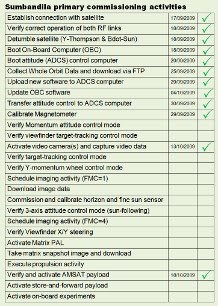With the satellite now Nadir pointing (ie the imager aperture and antennas continuously faces in the direction of Earth), our communication with the satellite has improved further. The next step is to start commissioning the various attitude sensors so that we can activate full three-axis control on the satellite.
All other systems continue to operate within nominal limits.
SunSpace was established in 2000 as a spin-off from Stellenbosch University following the successful launch of SUNSAT by NASA with a Delta-II launch vehicle. During the past decade SunSpace has developed and delivered numerous satellite components, subsystems and two flight model satellite, now operational in space. This blog documents the mission of Sumbandila (funded by the DST), launched on a Soyuz-2.1b on 17 September 2009. SunSpace places a high premium on a strong partnership with the South African Government for supplying the ongoing satellite needs of our government.
03 October 2009
Satellite Nadir pointing
The ADCS computer now runs a Y-momentum wheel controller that stabilizes the satellite with near-zero roll and yaw angles using data from the coarse sun sensors and a magnetorquer nutation damping controller. The main solar panel faces the sun in this control mode. The Y-wheel is controlled to track a reference pitch angle (as close as possible to zero).
30 September 2009
New software for ADCS processor
We have successfully uploaded new software for the ADCS processor (T800), containing the following changes:
- New coefficients for the 2009 IGRF model
- Latest NORAD elements
- Calibration values for the fluxgate magnetometer
- Minor modifications to code functionality
After verifying that the code is executing correctly, we have switched on a Y-Thompson attitude controller, for the first time transferring attitude control of the satellite to the ADCS processor (from the magnetic subsystem on which a basic controller was run up to now). From here we can proceed with the commissioning of the more advanced attitude controllers, which will finally lead to a 3-axis stabilised satellite.
The OBC is running more reliably after modifying some EDAC parameters. We have identified a couple of improvements to the flight code which will be uploaded soon. This will affect only some of the software modules running on the QNX operating system, so that we do not have to upload and replace all the flight software.
Subscribe to:
Posts (Atom)
Current Keplerian Elements
Last Update: 1 Febr 2010
Element set: 404
Sumbandila 1 35870U 09049F 10032.48635300 .00000433 00000-0 21444-4 0 4040 2 35870 097.3525 084.8560 0011505 166.1189 300.7196 15.22856092 20818

